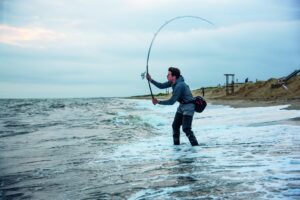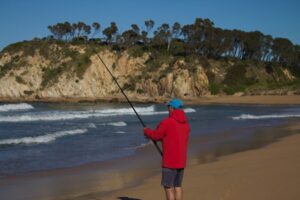Surf fishing is an exhilarating way to enjoy the great outdoors, combining the thrill of fishing with the beauty of the ocean. Whether you’re a seasoned angler or a novice looking to try something new, surf fishing offers a unique challenge that can be both rewarding and relaxing. This guide will walk you through everything you need to know about surf fishing, from choosing the right equipment to mastering essential techniques. By the end, you’ll be ready to hit the beach and start catching fish right from the shore.
Understanding Surf Fishing
What is Surf Fishing?

Surf fishing involves casting your line from the shoreline into the surf zone, where waves break on the beach. This type of fishing targets a variety of fish species that inhabit the shallow waters near the shore, such as striped bass, bluefish, redfish, flounder, and pompano. The appeal of surf fishing lies in its accessibility—you don’t need a boat, just a good spot on the beach, some basic equipment, and a bit of patience.
Best Locations for Surf Fishing

The success of your surf fishing adventure largely depends on location. Ideal spots include:
- Beaches with Gradual Slopes: Fish are more likely to feed where the beach slopes gently into the ocean, creating a smooth surf zone.
- Sandbars: These submerged ridges attract fish looking for food.
- Jetties and Piers: Structures like these create breaks in the current, where fish often gather.
- Troughs and Cuts: These are deeper areas between sandbars where fish tend to congregate.
Understanding Tides and Weather
Tides and weather conditions play a crucial role in surf fishing. Fish are more active during high tide, especially as it begins to rise. This is because the incoming water brings food closer to the shore. Overcast days with moderate waves often provide the best conditions, as they encourage fish to come closer to the beach without being overly disturbed by the sun or rough surf.
Essential Surf Fishing Gear
Rod and Reel
For surf fishing, you’ll need a rod that’s longer and sturdier than a standard fishing rod. A 9 to 12-foot rod is ideal, as it allows you to cast farther into the surf. Pair it with a reel that can hold at least 250 yards of line—spinning reels are popular due to their ease of use.
Line
A strong, abrasion-resistant line is crucial for surf fishing, where you’ll often be casting over rough sand, shells, and rocks. A 20 to 30-pound test monofilament or braided line is typically recommended.
Terminal Tackle
Your terminal tackle will include:
- Hooks: Sizes 2/0 to 4/0 are common for surf fishing.
- Sinkers: Pyramid sinkers work well in the surf because they dig into the sand and hold your bait in place. The weight of the sinker depends on the surf conditions, but 2 to 4 ounces is a good starting point.
- Rigs: The most popular rig for surf fishing is the fish-finder rig, which allows the bait to move naturally in the surf. Other options include the high-low rig and the Carolina rig.
Bait and Lures
Live bait is often the most effective for surf fishing. Common choices include:
- Shrimp
- Sand crabs
- Squid
- Bloodworms
- Cut bait
Artificial lures like spoons, plugs, and soft plastics can also be effective, especially for targeting specific species like bluefish or striped bass.
Other Necessary Equipment
- Tackle Box: To keep your gear organized.
- Cooler: For storing bait and your catch.
- Rod Holders: These allow you to keep your rod steady while you wait for a bite.
- Waders: Useful if you plan on fishing in colder waters or want to get further into the surf.
- Pliers and Knives: For handling hooks and cleaning fish.
Surf Fishing Techniques
Casting
Casting in surf fishing is all about distance and accuracy. The goal is to get your bait beyond the breaking waves, where fish are feeding. To achieve this, stand with your feet shoulder-width apart, bring the rod back over your shoulder, and cast with a smooth, powerful motion. Practice makes perfect, so don’t be discouraged if your first few casts don’t go as far as you’d like.
Bait Presentation
Proper bait presentation is key to attracting fish. Ensure your bait is securely hooked but still able to move naturally in the water. For live bait, hook it through the back or tail to allow it to swim naturally. If using cut bait, consider using a smaller piece to make it more manageable and appealing to fish.
Reading the Water
Understanding how to read the water is an essential skill in surf fishing. Look for signs of fish activity, such as birds diving, fish jumping, or ripples on the water’s surface. Also, pay attention to the color of the water—a sudden color change often indicates a drop-off or channel where fish might be lurking.
Hooking and Fighting Fish
When you feel a bite, resist the urge to immediately set the hook. Instead, give the fish a moment to take the bait before pulling back firmly on the rod to set the hook. Once hooked, keep the line tight and use a steady, controlled motion to reel in the fish. Be prepared for the fish to put up a fight, especially in the surf, where the waves can add to the challenge.
Surf Fishing Etiquette and Safety
Respecting Other Anglers
Surf fishing is often done in popular beach areas, so it’s important to be mindful of others. Maintain a reasonable distance from other anglers, avoid casting over their lines, and be courteous if you need to cross paths.
Protecting the Environment
Always clean up after yourself, including disposing of fishing lines, bait containers, and any other trash properly. Be mindful of local regulations regarding catch limits and protected species to help preserve the marine ecosystem.
Safety Tips
Surf fishing can be physically demanding, so always be aware of your surroundings. Watch out for strong currents, waves, and marine life like jellyfish or stingrays. Wearing a life jacket is a good idea, especially if you’re wading into deeper water. Also, protect yourself from the sun with sunscreen, a hat, and sunglasses.
Conclusion: Enjoying the Surf Fishing Experience
Surf fishing is more than just a way to catch fish; it’s a way to connect with nature, enjoy the beach, and experience the thrill of the hunt. With the right equipment, techniques, and a bit of patience, you’ll soon find yourself hooked on this exciting form of fishing. Remember, every trip is a learning experience, so take the time to observe, experiment, and enjoy the process. Happy fishing!

